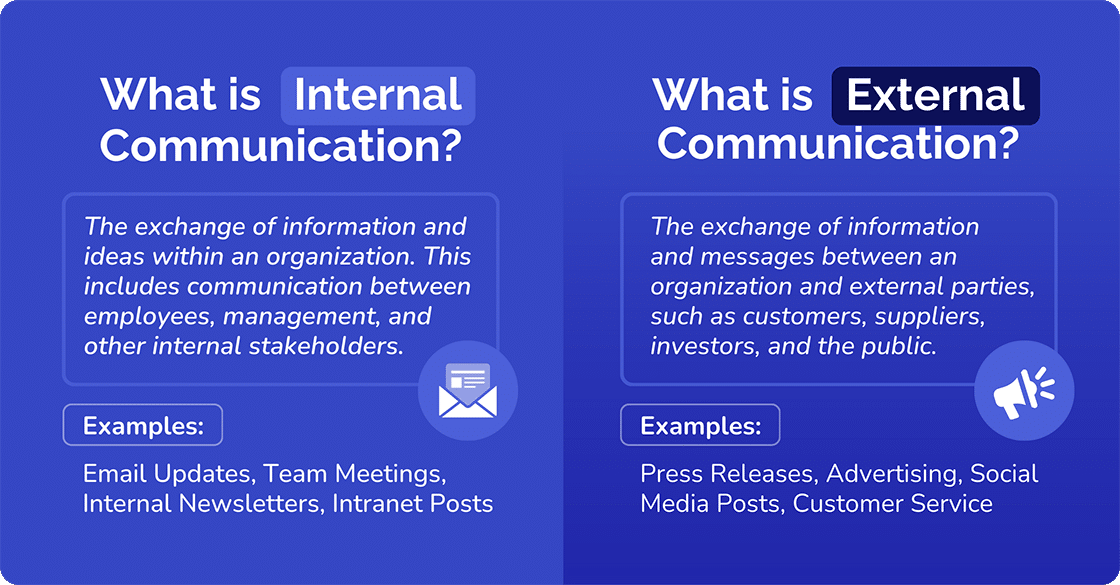 Employee Communication Best Practices
Employee Communication Best Practices
Internal and external communication, sometimes called mixternal comms and employed as a joint strategy, are both vital for business success. Here’s why.

.webp)
Effective internal communication is the backbone of every successful organization. Learn the ins and outs of internal communications with our research-backed white paper.
Access NowInternal and external communication are both fundamental to organizational success and essential in private and public-sector work environments. Internal communication occurs within an organization, while external communication happens outside the organization. Understanding these two types of communication and their importance is crucial for the success and smooth operation of any business.
Essentially, effective internal communications lead to better alignment among employees, which in turn enhances the consistency and effectiveness of external communication efforts. This alignment is crucial for maintaining a coherent brand image and building trust with external stakeholders.

Mixternal comms represents a trend that became evident during 2023. It combines internal and external communication, combining communication strategies that blend internal and external elements. It probably originated from the evolving landscape of organizational communication, where the boundaries between internal (employee-focused) and external (customer, partner, or public-facing) communications have become increasingly blurred.
In this post, we will take a closer look at internal and external communication and discuss their interdependence. We will also talk more about mixternal communications, its origins, and its benefits.
Internal communication refers to the exchange of information and ideas within an organization. This includes communication between employees, management, and other internal stakeholders. It encompasses all forms of communication, whether formal or informal, verbal or nonverbal, that occur within an organization to coordinate activities, share knowledge, build relationships, and maintain organizational culture. Effective internal communications are crucial for aligning employees with the organization’s goals, fostering collaboration, and enhancing employee engagement and satisfaction.
Examples of internal communication include email updates, team meetings, internal newsletters, intranet posts, and instant messaging within the organization.
Whichever type of communication you use it is essential that it is tailored to the specific needs and roles of different employee levels. While all employees deserve clear and timely information, the content and delivery of communication may vary based on factors such as job responsibilities, seniority, and decision-making authority. For example, top executives may require more in-depth reports and analyses, while frontline employees may benefit from concise, action-oriented messages. By customizing communication to meet the needs of each employee group, organizations can ensure that information is relevant, accessible, and impactful.
Turn your internal communications strategy around today

External communication is the process of exchanging information and messages between an organization and external parties, such as customers, suppliers, investors, government agencies, and the public. It involves communicating the organization’s messages, brand image, and values to the outside world. External communication is essential for building and maintaining stakeholder relationships, managing the organization’s reputation, and promoting its products or services.
Examples of external communication include press releases, advertising, social media posts, customer service interactions, promotional email signature banner, and public relations efforts.
In external communications, it is also crucial to tailor messages to the specific audience you are targeting. You need to consider roles, needs, and expectations. When communicating with external stakeholders, such as customers, investors, or government agencies, the message must resonate with their level of influence and interest in the organization. For example, a communication strategy that effectively addresses customer concerns may differ significantly from one aimed at investors or regulatory bodies. Ensuring that each message is appropriately crafted not only strengthens relationships but also enhances the organization’s credibility and reputation.
By aligning communication strategies with the type and stature of each external stakeholder, organizations can more effectively convey their brand values, respond to stakeholder needs, and achieve their broader business objectives.

Both internal and external communication are vital for an organization’s success, but they differ in several key aspects. Understanding these differences can help internal communicators to effectively manage and utilize both types of communication.
As we’ve already mentioned, external and internal audiences differ, as do the delivery methods used for each type. Their purpose, focus, frequency, and level of formality also differ.
The objectives of internal vs external communication are distinctly different. Internal communications aim to share information, coordinate activities, motivate employees, and build a cohesive work environment. It supports collaboration, informs employees about company policies, and fosters company culture.
External communication aims to build and maintain a positive image of the organization, manage public relations, market products or services, and manage customer relationships. It is crucial for brand-building, customer satisfaction, and overall business development.
Internal communications tend to occur more frequently than external communication. Regular updates, team meetings, and internal newsletters are common, and communication can be daily or weekly. This continuous flow of information helps maintain transparency and keeps everyone on the same page.
External communication is typically less frequent but is equally important. It’s often driven by marketing campaigns, public relations events, or significant updates. Examples include monthly newsletters to customers, quarterly earnings reports to investors, and periodic press releases.
Internal communications focus primarily on operational matters, policy updates, employee engagement, and internal processes.
External communication focuses on brand management, marketing strategies, public relations, and stakeholder engagement.
Internal communication can range from informal chats to formal announcements. For example, quick updates can be shared through instant messaging platforms, while critical information might be conveyed through official memos or meetings. The formality of internal communication often depends on the context and nature of the information being shared.
External communication generally maintains a higher level of formality, especially when dealing with stakeholders — from clients to investors or regulatory bodies. This is because the information shared externally can significantly impact the organization’s relationships, reputation, and bottom line.

Internal and external communication are not isolated processes. They influence each other all the time. A well-informed and engaged workforce often plays an important role in representing an organization in its external communication endeavors. Also, feedback from external communication can provide valuable insights for improving internal processes and strategies.
On the other hand, poor internal communication can lead to significant business losses. For instance, Project.co’s Communication Statistics 2024 shows that 12% of companies have lost employees due to communication issues. Their report also reveals that 66% of customers have switched to competitors because of the poor business communication skills of the company they were dealing with.
For an organization to thrive, there has to be a seamless integration of internal and external communication. When both communication types are in harmony, you can create a cohesive message that resonates both within and outside the organization.
A key aspect of this interdependence is employee advocacy. When employees are well informed and engaged, they become advocates for the organization, bridging the gap between internal and external communication. Their positive representation of the company to external stakeholders can significantly enhance the organization’s reputation and credibility.
Another aspect of this interdependence is company sustainability. A sustainability study published in 2024 shows that both internal and external communication are crucial for effectively promoting sustainability in companies. Thinking Out Loud? Internal vs. External Communication of Sustainability in Companies emphasizes the need for companies to balance and integrate their internal and external communication strategies to ensure consistent messaging and support overall sustainability objectives.
This brings us to the concept of mixternal comms.
Essentially, mixternal communication represents the strategic blending of internal and external communication within an organization. This approach recognizes that the lines between the two forms of communication are increasingly blurred, especially in the digital age where employee and customer feedback often intersect on public platforms.
The concept has gained traction as a way to ensure consistency across messaging, strengthen collaboration, and leverage content effectively across both audiences. For example, user-generated content from employees can be repurposed for external marketing campaigns, while external customer feedback can be integrated into internal communications to keep employees informed and engaged.
Recent discussions highlight the growing importance of this approach in breaking down organizational silos and enhancing the overall internal communication strategy. This not only supports brand integrity but also fosters a more unified corporate culture.
Sandy Pound, Chief Communication Officer at Thermo Fisher Scientific, highlights how the pace of information exchange has changed radically. “Not to age myself, but when I first started working in communications, there was a hard line between internal and external communications.” This was before laptops and cell phones became commonplace. Now, rather than a firm line, she sees internal and external communication becoming one. It’s an observation shared by many.
Turn your internal communications strategy around today

Several companies have explored the mixternal comms concept in depth in the past three or four years. A common theme is that companies advocated its adoption because of the need for integrated communication strategies following the COVID-19 pandemic.
Ragan Communications has been highlighting the value of mixternal comms since 2021. So unsurprisingly, it was a topic discussed at the company’s 2023 Strategic Communications Conference.
In How and why the ‘mixternal’ comms trend is accelerating, Ragan Content Manager Ted Kitterman states that understanding how the employee and the customer experience are intrinsically linked for an organization is at the heart of the mixternal movement. But that doesn’t mean they are exactly the same. After all, employees are very different from typical stakeholders and customers.
Emphasizing that “the trend was already well underway before 2020,” he says COVID-19, increasing remote work, and other challenges of that year “accelerated the rise of employee experience and the need for mixternal comms.”
Public relations agency Red Havas was the guest of social media monitoring company NewsWhip in a “Pulse” episode, Misternal communications: How internal and external communications are becoming one. The Global CEO of Red Havas, James Wright, also linked the emergence of mixternal communications to the pandemic.
“Mixternal communications is really an integrated strategic approach to engage both internal and external audiences through coordinated efforts in messaging, in content, and in channel strategy.” James Wright
He says the two questions to ask are:
For his clients, this approach has been a crucial factor. The reason is simple: “If they don’t ensure their internal and external messaging matches, there could potentially be a reputation risk.”
Global online corporate communications specialist Bowen Craggs features Nestlé’s mixternal strategy in an online article. Taking a “Mixternal” approach at Nestlé by Georgia Barrett, Vice President USA at Bowen Craggs, is based on a 2023 interview with Amy Howard, Head of Internal Communications and Employee Engagement at Nestlé.
Amy identified “mixternal” as content that is produced specifically for internal and external audiences. At Nestlé, she said, internal and external communication are closely aligned. Even though they don’t replicate internal and external content, the information on their intranet and internal social media network mirrors the content on Nestlé’s public website. What this means is that they can point internal stakeholders and employees to Nestle.com to find information. This saves resources and time.
“The topics may be the same, but the way we talk about them could be different. Sometimes we adapt the language or highlight specific project teams or individuals behind the story.” It ensures a certain consistency that is reassuring because “employees see the same side of the company inside as they do on the outside.”
Nestlé also finds that the mixternal approach helps build the company’s reputation. For instance, employees often post content on platforms like LinkedIn, sharing news that makes them feel proud. In fact, she advocates that employees are one of the company’s most important stakeholders.
“Talking about purpose and values both internally and externally, and sharing employee stories both inside and out, are all transparent, trusted and reassuring ways of communicating.” Amy Howard
This is all recent history. Let’s look at the impact that applies to organizations today.
There are undoubtedly loads of benefits when mixternal comms are integrated the right way.
Steegle, a Google Cloud Partner and independent consultancy, advocates adopting a mixternal communication approach to build stronger relationships with stakeholders, enhance their brand image and reputation, and improve the effectiveness of their communications overall.
Discover What is Mixternal Communications warns that while this approach can be complex, it has loads of benefits. These include:
In Breaking down silos with ‘mixternal’ communication, Justin Joffe, Ragan Communications Editor-in-Chief, talks about how a mixternal approach is the best way to give internal and external audiences what they want. He, too, emphasizes the role mixternal comms has in dismantling or eliminating silos.
Even more recently, in January 2025, Shaun Randol, founder of the Mixternal Comms PlayBook, wrote an article titled, Your internal/external teams are working against each other. Mixternal fixes that. His message is that by clinging to “a traditional false divide” tends to result in both redundancy and missed opportunities.
By adopting a mixternal approach, organizations can maximize the strategic value and return on investment of their communications efforts. This involves creating content that serves multiple audiences and channels, thereby increasing efficiency and ensuring consistent messaging. The article also highlights the role of AI in facilitating the repurposing of content across various platforms, making mixternal communications an operational necessity in the evolving corporate landscape.

Effective communication is essential for any organization, and Cerkl Broadcast offers advanced solutions to enhance internal communication. Broadcast has a tailored, personalized communication approach, with a focused Audience Manager to help internal communicators engage and inform employees. The Broadcast platform serves as a centralized, mobile-friendly information hub that allows employees to access information on the go and from their preferred devices.
Cerkl Broadcast’s engagement analytics tools help organizations track engagement, identify knowledge gaps, and measure the ROI of their communication efforts. This data-driven approach enables continuous improvement of communication strategies, ensuring they meet organizational needs.
In a nutshell, Broadcast provides a comprehensive solution to improve communication and enhance the overall employee experience.
We’ve created a white paper on the importance of internal communication that can help you improve your internal communications plan. It explores employee engagement relationships and shows how this leads to communication that will impact your organization’s bottom line. This valuable resource is available at the moment, absolutely free of charge.

Turn your internal communications strategy around today
What is the difference between internal and external communication? Internal communication occurs within an organization and involves the exchange of information among employees and management. External communication involves interactions between the organization and external parties such as customers, suppliers, and the public.
What are internal and external communication examples? Internal communication examples include team meetings, employee newsletters, and internal emails. External communication examples include press releases, advertising campaigns, and customer service interactions.
What is an internal and external audience in communication? An internal audience involves employees and management within an organization. An external audience includes customers, investors, suppliers, and those who interact with the organization from outside the company.

Turn your internal communications strategy around today